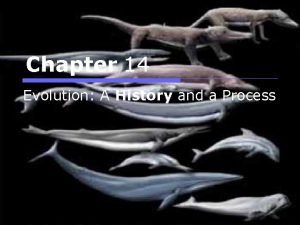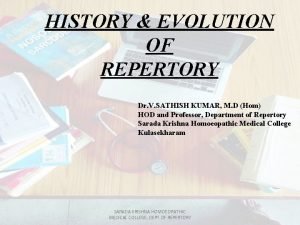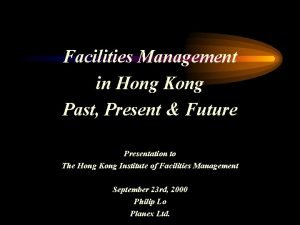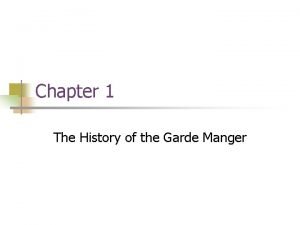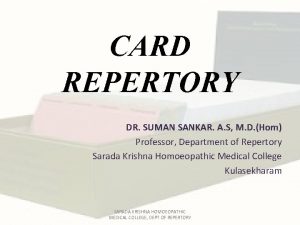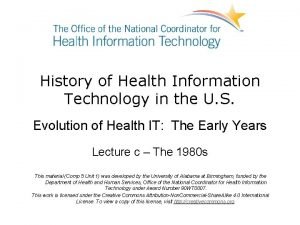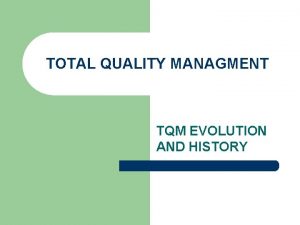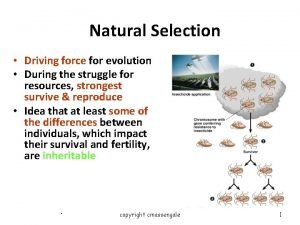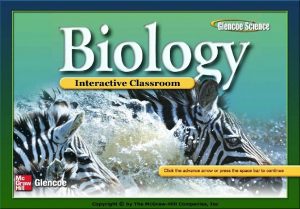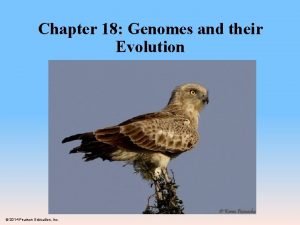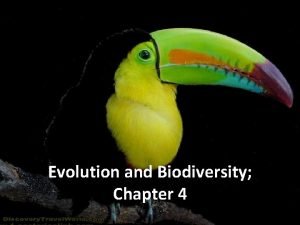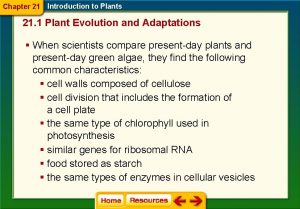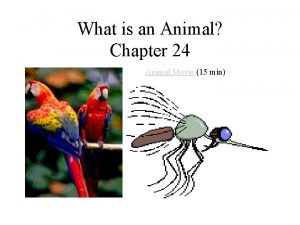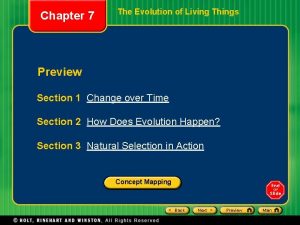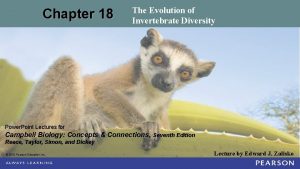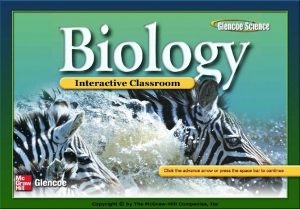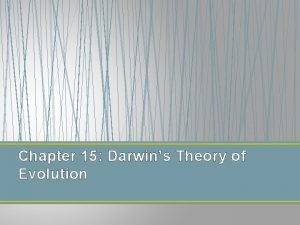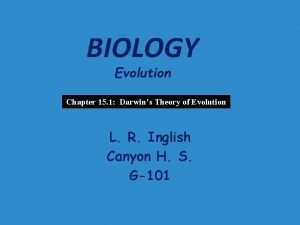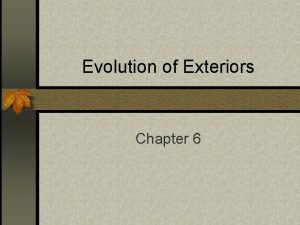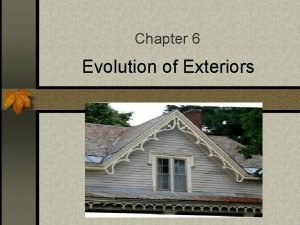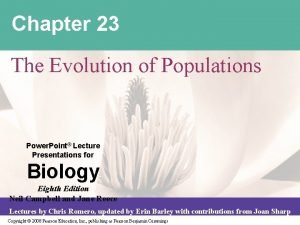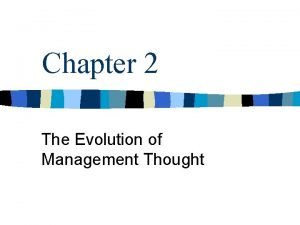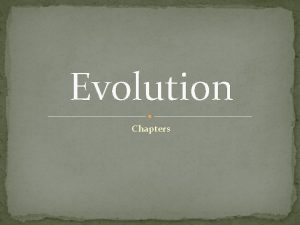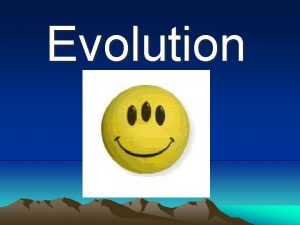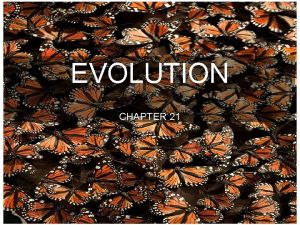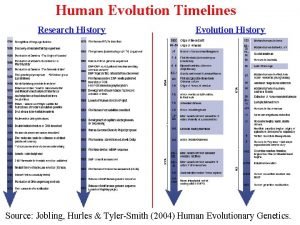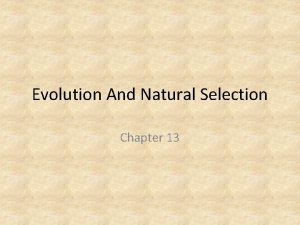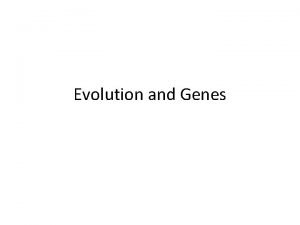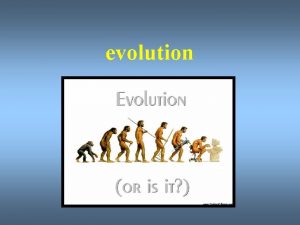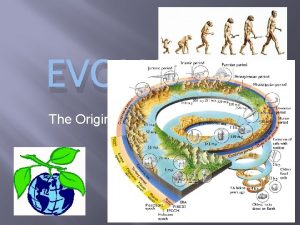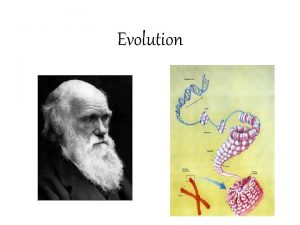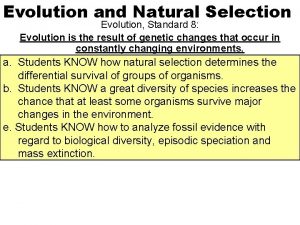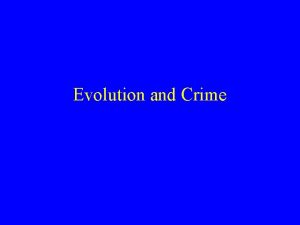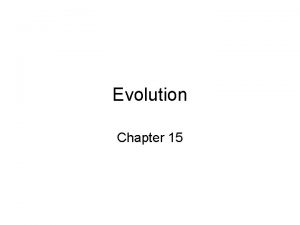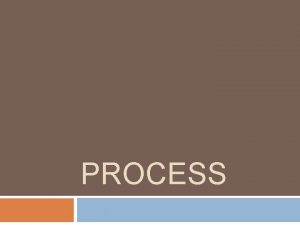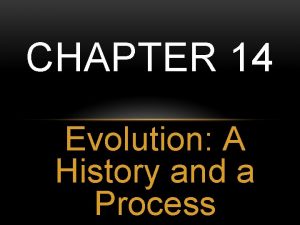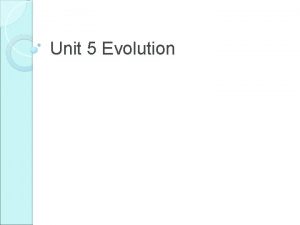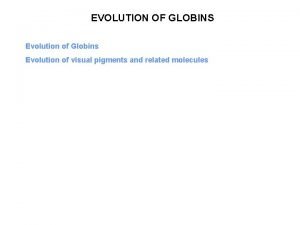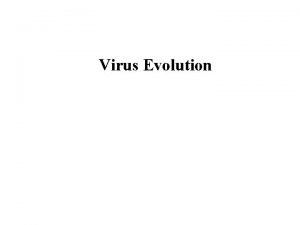Chapter 14 Evolution A History and a Process































- Slides: 31

Chapter 14 Evolution: A History and a Process

14. 1 Darwin Developed a Theory of Evolution Ideas From Darwin’s Time o Evolution: change over time o Before mid-1700 s: n Species are permanent, do not change. n Earth is <10, 000 yrs old & unchanging. o Georges Buffon (mid-1700 s) n Studied fossils n Believed Earth to be older n Decided that certain living animals were similar, but not exact to their ancestors

14. 4 Notes… Ideas From Darwin’s Time o Jean Lamarck (early 1800 s) n Proposed that life changes n Changes occur as process of adaptation n Adaptation: Inherited characteristic that improves an organism’s ability to survive and reproduce. n Inheritance of Acquired Characteristics: organism can pass on characteristics acquired during its lifetime to its offspring e. g. Kangaroo’s powerful legs were result of ancestors jumping & passing leg strength to offspring -Proven false, adaptation requires modification of DNA

14. 1 Notes… The Voyage of the Beagle o 1831 - Voyage around world n Chart coastline of S. America for British navy o Charles Darwin (22 yrs) on board HMS Beagle n Study geology, plants & animals during voyage.

14. 1 Notes… Darwin’s Observations n Observed thousands of specimens. n Kept extensive journals & recorded observations n Plants & animals in S. A. are different from European species. n Interested in Galapagos islands: o Galapagos species were similar but different from S. A. mainland species o Species on some Galapagos islands were similar to, but different from, species on nearby islands. n Concluded that species changed to adapt to new environments

14. 1 Notes Ideas From Geology n Darwin reads books by Charles Lyell (geologist) o Lyell suggested physical changes to Earth result from geologic processes occurring over long periods of time. Example: erosion of river bed = river canyon n Darwin experiences earthquake in Chile o Land below water shifts above water o Ocean fossils in Andes Mts. n Concludes that earth is very old and processes over time cause changes to earth.

14. 1 Notes… Darwin Publishes His Theory o Darwin becomes famous upon return to England o Darwin builds his theory n Reads essay by Thomas Malthus, who believes populations can grow faster than the rate of resources, causing species to struggle to survive n Writes 200 pg essay about his ideas & gathers more info. o Publishes book called The Origin of Species

14. 1 Notes… Darwin’s Two Main Points of Darwin’s book 1. Descent with Modification -All species descended from ancestral species -Spread into various habitats -Accumulated different adaptations to various ways of life 2. Natural Selection -Individuals with inherited characteristics well-suited to environment leave more offspring Snowshoe hare Jackrabbit Peppered Moth

14. 2 Evolution Has Left Much Evidence The Fossil Record q Evolution has left much evidence. q Fossils: preserved remains or markings left by organisms that lived in the past. o Most fossils are found in sedimentary rock layers n n Sand & silt deposit, pile up, & compress into layers Organisms become fossils if buried under deposits

14. 2 Notes… The Fossil Record o Fossil Record: collection of fossils recorded in rock layers over time. o Fossils provide evidence for earth’s changing life. o Fossils of extinct species can help link past & present life forms.

14. 2 Notes Geographic Distribution o How organisms are distributed throughout the world gives clues to how species may have evolved. e. g. Many unique species evolved on the isolated island of Australia -Marsupials: Kangaroos and Koalas -Why? Possibly isolated with common marsupial ancestor.

14. 2 Notes… Similarities in Structure o Similarities in structure among species provide clues to evolutionary history. o Homologous Structures: similar structures among related species, but differing functions.

14. 2 Notes Similarities in Structure o Vestigial Structures: structures that have a major function in one species but not in a related species n No clear function n May have been important at one time e. g. whale & vestigial hipbones

14. 2 Notes… Similarities in Development o Comparing the development of different organisms can give clues about evolution o Related species have similar embryonic stages e. g. Vertebrates (fishes, frogs, snakes, birds & primates) have pouch on side of throat during embryonic stage o Embryonic structures develop into species-specific structures e. g. pouch forms into skull bones or gills

14. 2 Notes… Molecular Biology o DNA sequences in organisms shows similarities and differences o DNA is passed down from parents to offspring o DNA sequences are similar in similar species & different in different species. n Compare # of genes & proteins

14. 3 Darwin Proposed natural Selection as the Mechanism of Evolution Darwin’s Theory of Natural Selection o Natural selection helps explain adaptive evolution o Population: group of individuals of the same species living in the same area at the same time. o Finches on Galapagos Islands n n n S. A. finch species colonizes Galapagos islands Finch populations on different islands adapt to local environments, diversify & become 13 separate species. Beaks adapted for specific foods on different island-Why? Natural selection

How did these different beaks arise? Darwin proposes the differences arise through natural selection

14. 3 Notes… Darwin’s Theory of Natural Selection o Theory based on 2 sets of observations 1. Species tend to produce more individuals than environment can support -Members of a population struggle to survive, only strongest survive. 2. There is variation or differences among members of the same species -Passes from generation to generation

14. 3 Notes… Population of Organisms Darwin’s Theory of Natural Selection ↓ n Individuals with inherited traits that are best suited to the environment are more likely to survive and reproduce than less fit individuals. Overproduction ↓ Variation Struggle for Existence ↓ o Natural Selection: ↓ Differences in Reproductive Success ↓ Evolution of Adaptations ↓

14. 3 Notes… Artificial Selection o Artificial selection: Selective breeding of plants and animals to produce offspring with genetic traits that humans value o Change occurs quickly e. g. diversity of dog species in 500 yrs o In contrast, natural selection favors traits that benefit organism, environment does “selective breeding”.

14. 3 Notes Pesticides-Natural Selection in Action o Evolution observable in pesticide resistance insect species o By spraying crops with poisons to kill insects, humans have favored the reproduction of insects with inherited resistance. e. g. Flour beetles that feed on grain

14. 4 Microevolution is a Change in a Population’s Gene Pool Populations and Their Gene Pools o A population is the smallest level at which evolution can occur. -natural selection is apparent when populations are tracked over time. o Gene Pool: all the alleles (alternative forms of genes) in all the individuals that make up a population.

14. 4 Notes… Changes in Gene Pools o Some alleles may be more common due to natural selection o Frequency of alleles= how often alleles occur in a gene pool o Microevolution: evolution on the smallest scale-a gen. to gen. change in the frequencies of alleles in population. o Hardy-Weinberg Equilibrium: frequency of alleles in the gene pool are constant over time. -Populations that do not undergo change are not presently evolving o What mechanisms change a gene pool? 1. Genetic Drift, 2. Gene Flow & Mutation 3. Natural Selection

14. 4 Notes… Genetic Drift o Genetic Drift: a change in the gene pool of a population due to chance. -smaller population = greater impact n The Bottleneck Effect: Reducing the size of the population (natural disasters), reduces the size of gene pool (genetic variation). E. g. Cheetahs n The Founder Effect: When few individuals, w/ little gen. variation, colonize an isolated island, lake or new habitat. E. g. Finches on Galapagos Islands

Genetic Drift

14. 4 Notes… Gene Flow & Mutation o Gene Flow: the exchange of genes with another population when fertile individuals or gametes migrate between populations e. g. Windstorm blows pollen from neighboring white flowers into a red-flowered population n Reduces the genetic differences between populations

14. 4 Notes… o Mutation: is a change in an organism’s DNA. n If the mutation is carried by a gamete, the mutation enters the population’s gene pool. n Natural selection can affect the frequency of the mutation in a population. e. g. albino deer n Mutations are an important source for variation in asexually reproducing organisms

14. 4 Notes… Natural Selection & Fitness o Genetic Drift, Gene Flow & Mutation cause microevolution or changes in allele frequencies. Only Natural Selection leads to adaptation! o Natural Selection = blend of chance & sorting o Fitness: the contribution that an individual makes to the gene pool of the next generation compared to the contributions of others. a. k. a “survival of the fittest”

14. 4 Notes… Natural Selection & the Galapagos o Peter & Rosemary Grant have studied finches in Galapagos for 30 years. Documented several cycles of natural selection. e. g. finches eat large seeds during dry years, those with large beaks are more successful, tend to survive & pass on trait

14. 5 Evolutionary Biology is Important in Health Science Natural Selection and Sickle Cell Disease o Sickle Cell Disease n Only homozygous individuals have the disease: caused by a recessive allele inherited from both parents. -1 out of 25 individuals in some African populations have the disease n People suffer symptoms including: weakening, pain, damage to organs & death. n Heterozygous individuals (one copy of allele) do not have disease but can pass it on. Benefit = Resistant to malaria. n Sickle Cell Disease is common in areas with highest amount of malaria parasite due to natural selection

14. 5 Notes… Evolution of Antibiotic Resistance in Bacteria o Antibiotics: medicines that kill or slow the growth of bacteria. Benefit: Saved lives of millions of people Risk: Caused evolution of antibiotic-resistant bacteria by natural selection n Drugs kills most of bacteria except those that can survive. Resistant bacteria multiply & become the norm. e. g. New York City & Tuberculosis Bacteria n Overuse of drugs is speeding the evolution of resistant bacteria
 Chapter 14 evolution a history and a process
Chapter 14 evolution a history and a process History of repertory
History of repertory Sss facility management services
Sss facility management services Garde manger history
Garde manger history Sharma card repertory image
Sharma card repertory image Doctrine of analogy in repertory
Doctrine of analogy in repertory History and evolution of health information technology
History and evolution of health information technology History of total quality management
History of total quality management Driving force
Driving force Chapter 5 evolution and community ecology
Chapter 5 evolution and community ecology Chapter 21 section 1 plant evolution and adaptations
Chapter 21 section 1 plant evolution and adaptations Chapter 18 genomes and their evolution
Chapter 18 genomes and their evolution Chapter 5 evolution and community ecology
Chapter 5 evolution and community ecology Chapter 5 evolution and community ecology answer key
Chapter 5 evolution and community ecology answer key Chapter 4 biodiversity and evolution
Chapter 4 biodiversity and evolution Chapter 21 section 1 plant evolution and adaptations
Chapter 21 section 1 plant evolution and adaptations Asymmetrical
Asymmetrical Chapter 16 evolution of populations vocabulary review
Chapter 16 evolution of populations vocabulary review Chapter 17 evolution of populations answer key
Chapter 17 evolution of populations answer key Chapter 15 darwin's theory of evolution
Chapter 15 darwin's theory of evolution Chapter 7 the evolution of living things answers
Chapter 7 the evolution of living things answers Chapter 23: the evolution of populations
Chapter 23: the evolution of populations Chapter 18 the evolution of invertebrate diversity
Chapter 18 the evolution of invertebrate diversity Chapter 17 darwin's theory of evolution
Chapter 17 darwin's theory of evolution Chapter 16 primate evolution study guide answer key
Chapter 16 primate evolution study guide answer key Chapter 16 evolution of populations
Chapter 16 evolution of populations Chapter 15 darwin's theory of evolution section review 15-1
Chapter 15 darwin's theory of evolution section review 15-1 Homologous structures definition biology
Homologous structures definition biology Chapter 6 the evolution of exteriors
Chapter 6 the evolution of exteriors Chapter 6 the evolution of exteriors
Chapter 6 the evolution of exteriors Chapter 23 the evolution of populations
Chapter 23 the evolution of populations Evolution of management
Evolution of management
